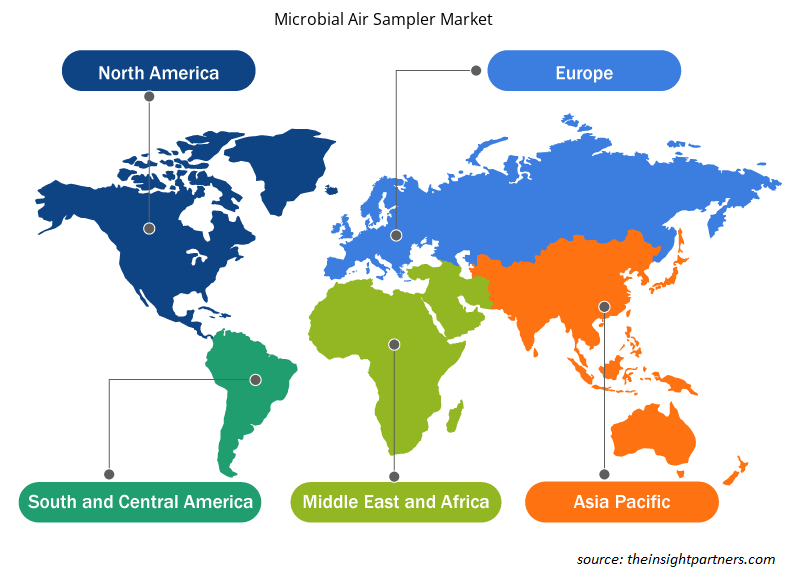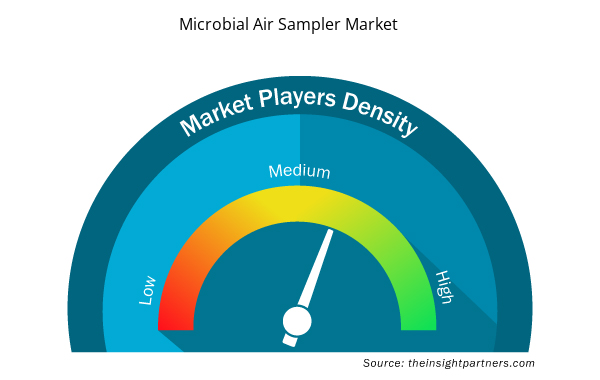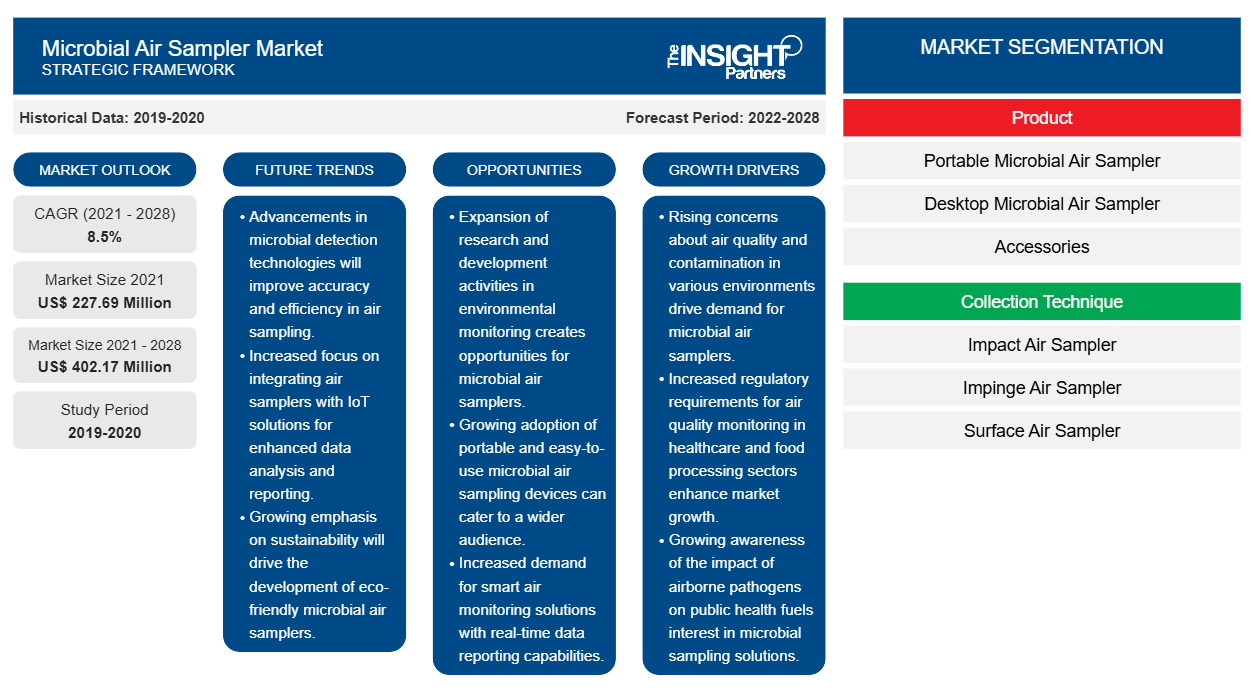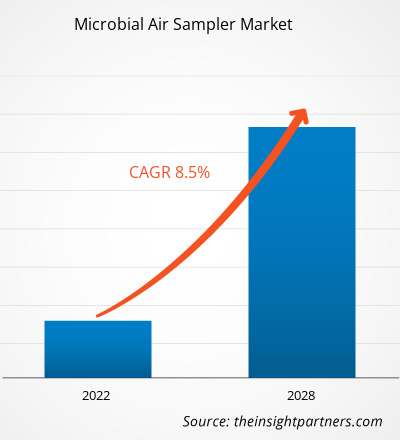Se espera que el mercado de muestreadores de aire microbianos crezca a partir deUS$ 227,69 millones en 2021 a US$ 402,17 millones en 2028; se estima que registrará una CAGR de 8,5% de 2021 a 2028.
Un muestreador de aire microbiano es un dispositivo para examinar partículas microbiológicas en el aire o en un entorno controlado. El muestreador de aire microbiano funciona introduciendo aire en un medio de recolección o sobre él durante un período específico. Luego, el cultivo obtenido se incuba y se evalúa la presencia del microbio en el aire de manera cualitativa y cuantitativa. Se puede utilizar para el examen microbiológico del aire durante las inspecciones de contaminación microbiológica en salas blancas y áreas de producción higiénicamente sensibles, así como en diversos equipos utilizados en la industria alimentaria.
El crecimiento del mercado de muestreadores de aire microbianos se atribuye principalmentea factores como el creciente uso de muestreadores microbianos de aire para combatir el COVID-19 y el aumento de casos de contaminación de alimentos por microbios.Sin embargo, las preocupaciones por las altas inversiones de capital para establecer laboratorios avanzados obstaculizan el crecimiento del mercado.
Personalice este informe según sus necesidades
Obtendrá personalización en cualquier informe, sin cargo, incluidas partes de este informe o análisis a nivel de país, paquete de datos de Excel, así como también grandes ofertas y descuentos para empresas emergentes y universidades.
- Obtenga las principales tendencias clave del mercado de este informe.Esta muestra GRATUITA incluirá análisis de datos, desde tendencias del mercado hasta estimaciones y pronósticos.
Perspectivas del mercado
Aumento de las actividades industriales en los mercados emergentes
El aumento de la industrialización en regiones como Asia Pacífico, América Latina y África ha aumentado la conciencia de las personas sobre la contaminación y la degradación ambiental. Las actividades económicas tienen el potencial de mejorar o degradar la calidad ambiental, lo que puede ayudar o dificultar las operaciones económicas. Se estima que la contaminación del aire ambiental es responsable de 4,2 millones de muertes por año debido a accidentes cerebrovasculares, enfermedades cardíacas, cáncer de pulmón y enfermedades respiratorias agudas y crónicas. Aproximadamente el 91% de la población mundial vive en áreas donde la calidad del aire excede el límite de la guía de la Organización Mundial de la Salud (OMS) para el nivel de contaminantes. Como resultado, se han promulgado numerosas leyes de protección ambiental, lo que brinda una oportunidad significativa para el mercado de muestreadores de aire microbianos. Los países emergentes creen que las leyes ambientales estrictas afectarán negativamente a sus industrias "intensivas en contaminación". Además, las regulaciones ambientales en las naciones desarrolladas siempre son más estrictas que en las en desarrollo. En los próximos cinco años, es probable que se implementen varios cambios y nuevas normas de seguridad ambiental, principalmente en economías en desarrollo en regiones como Asia Pacífico debido al aumento de la contaminación y la contaminación ambiental. Es probable que el desarrollo constante de métodos de prueba innovadores para muestras de contaminantes como residuos de pesticidas, metales pesados y compuestos orgánicos contribuya significativamente al crecimiento del mercado. En marzo de 2021, Bertin Technologies lanzó muestreadores de aire Coriolis para recolectar el SARS-CoV-2 responsable de la COVID-19 y evaluar el riesgo de contaminación por aerosoles en áreas críticas. En mayo de 2021, Aerosol Devices Inc anunció el lanzamiento del nuevo muestreador BioSpot-GEM diseñado especialmente para aplicaciones de campo, donde se requiere un muestreador de virus fácil de usar (también para otras partículas biológicas). La OMS está desarrollando un kit de herramientas de soluciones de energía limpia para el hogar (CHEST) para monitorear y evaluar materiales con el fin de abordar la contaminación del aire en el hogar.
Perspectivas basadas en productos
El mercado de muestreadores de aire microbianos, por producto, se segmenta en muestreadores de aire microbianos portátiles, muestreadores de aire microbianos de escritorio y accesorios. El segmento de muestreadores de aire microbianos portátiles tuvo la mayor participación del mercado en 2021 y se prevé que registre la CAGR más alta durante el período de pronóstico.
Perspectivas basadas en técnicas de recopilación
Por técnica de recolección, el mercado de muestreadores de aire microbianos se segmenta en muestreadores de aire de impacto, muestreadores de aire de impacto, muestreadores de aire de superficie, muestreadores de aire comprimido, muestreadores en tiempo real y otros. En 2021, es probable que el segmento de muestreadores de aire de impacto tenga la mayor participación del mercado y se espera que crezca al ritmo más rápido durante los próximos años.
Información basada en el usuario final
Según el usuario final, el mercado de muestreadores de aire microbianos se segmenta en institutos de investigación y académicos, hospitales y clínicas, empresas farmacéuticas y biotecnológicas, industrias de alimentos y bebidas, cuidado personal y otros. Es probable que el segmento de institutos de investigación y académicos tenga la mayor participación del mercado en 2021 y se prevé que registre la CAGR más alta durante el período de pronóstico.
Información basada en canales de distribución
Según el canal de distribución, el mercado de muestreadores de aire microbianos se segmenta en licitación directa, ventas minoristas, distribuidores externos y otros. Es probable que el segmento de licitación directa tenga la mayor participación del mercado en 2021 y se prevé que registre la CAGR más alta durante el período de pronóstico.
Los lanzamientos y aprobaciones de productos son estrategias que las empresas suelen adoptar para ampliar su presencia global y sus carteras de productos. Además, los actores del mercado de muestreadores de aire microbianos se centran en la estrategia de asociación para ampliar su clientela, lo que, a su vez, les permite mantener su marca a nivel mundial.
Perspectivas regionales del mercado de muestreadores de aire microbianos
Los analistas de Insight Partners explicaron en detalle las tendencias y los factores regionales que influyen en el mercado de muestreadores de aire microbianos durante el período de pronóstico. Esta sección también analiza los segmentos y la geografía del mercado de muestreadores de aire microbianos en América del Norte, Europa, Asia Pacífico, Oriente Medio y África, y América del Sur y Central.

- Obtenga datos regionales específicos para el mercado de muestreadores de aire microbianos
Alcance del informe de mercado de muestreadores de aire microbianos
| Atributo del informe | Detalles |
|---|---|
| Tamaño del mercado en 2021 | US$ 227,69 millones |
| Tamaño del mercado en 2028 | US$ 402,17 millones |
| CAGR global (2021-2028) | 8,5% |
| Datos históricos | 2019-2020 |
| Período de pronóstico | 2022-2028 |
| Segmentos cubiertos | Por producto
|
| Regiones y países cubiertos | América del norte
|
| Líderes del mercado y perfiles de empresas clave |
|
Densidad de los actores del mercado de muestreadores de aire microbianos: comprensión de su impacto en la dinámica empresarial
El mercado de muestreadores de aire microbianos está creciendo rápidamente, impulsado por la creciente demanda de los usuarios finales debido a factores como la evolución de las preferencias de los consumidores, los avances tecnológicos y una mayor conciencia de los beneficios del producto. A medida que aumenta la demanda, las empresas amplían sus ofertas, innovan para satisfacer las necesidades de los consumidores y aprovechan las tendencias emergentes, lo que impulsa aún más el crecimiento del mercado.
La densidad de actores del mercado se refiere a la distribución de las empresas o firmas que operan dentro de un mercado o industria en particular. Indica cuántos competidores (actores del mercado) están presentes en un espacio de mercado determinado en relación con su tamaño o valor total de mercado.
Las principales empresas que operan en el mercado de muestreadores de aire microbianos son:
- Dispositivos de aerosol Inc.
- ORUM INTERNACIONAL
- Acuario Srl,
- Cantium Scientific Limited,
- Laboratorios Cherwell,
Descargo de responsabilidad : Las empresas enumeradas anteriormente no están clasificadas en ningún orden particular.

- Obtenga una descripción general de los principales actores clave del mercado de muestreadores de aire microbiano
El informe segmenta el mercado de muestreadores de aire microbianos de la siguiente manera:
Mercado de muestreadores de aire microbianos: por producto
Mercado de muestreadores de aire microbianos: por técnica de recolección
- Muestreador de aire de impacto
- Muestreador de aire por impacto
- Muestreador de aire de superficie
- Muestreador de aire comprimido
- Muestreadores en tiempo real
- Otros
Mercado de muestreadores de aire microbianos: por usuario final
- Institutos de investigación y académicos
- Hospitales y Clínicas
- Empresas farmacéuticas y biotecnológicas
- Alimentos y bebidas
- Industrias del cuidado personal
- Otros
Mercado de muestreadores de aire microbianos: por canal de distribución
- Licitación directa
- Ventas al por menor
- Distribuidor externo
- Otros
Mercado de muestreadores de aire microbianos: por geografía
- América del norte
- A NOSOTROS
- Canadá
- México
- Europa
- Reino Unido
- Alemania
- Francia
- Italia
- España
- Resto de Europa
- Asia Pacífico
- Porcelana
- Japón
- India
- Australia
- Corea del Sur
- Resto de Asia Pacífico
- Oriente Medio y África
- Emiratos Árabes Unidos
- Arabia Saudita
- Sudáfrica
- Resto de Oriente Medio y África
- América del Sur y Central
- Brasil
- Argentina
- Resto de América del Sur y Central
Perfiles de empresas
- Dispositivos de aerosol Inc.
- ORUM INTERNACIONAL
- Acuario Srl,
- Cantium Scientific Limited,
- Laboratorios Cherwell,
- Multitech Enviro Analytical LLP,
- Corporación Spectrex
- Instrumentos Munro Limitada
- Compañía Merck KGaA,
- BioMerieux SA
- Análisis histórico (2 años), año base, pronóstico (7 años) con CAGR
- Análisis PEST y FODA
- Tamaño del mercado Valor/volumen: global, regional, nacional
- Industria y panorama competitivo
- Conjunto de datos de Excel



Report Coverage
Revenue forecast, Company Analysis, Industry landscape, Growth factors, and Trends

Segment Covered
This text is related
to segments covered.

Regional Scope
North America, Europe, Asia Pacific, Middle East & Africa, South & Central America

Country Scope
This text is related
to country scope.
Preguntas frecuentes
The microbial air sampler market is led by collection technique segment Impact air samplers offer benefits in terms of ease, and pre-poured, gamma-irradiated contact plates and standard Petri dishes can be utilized with them to reduce the risk of variation and contamination. They are also able to manage higher flow rates and the large sample volumes essential to monitor air quality in cleanrooms where the concentration of microbe present is likely to be very low. A wide variety of instruments have been developed employing the impaction principle. One of the best known is the Andersen sampler, a multi-stage ‘cascade’ sieve sampler that utilizes perforated plates with progressively smaller holes at each stage, allowing particles to be separated according to size. Another well-known instrument is the Casella slit sampler. With this constant innovation the impact air sampler segment is likely to grow with a good pace in the forecasted period.
An increase in microbial air sampling applications in the food and pharmaceutical industries, as well as consistent innovation, is leading to the development of advanced microbial air samplers, which are expected to drive market growth. Various companies are involved in the development of innovative microbial air samplings. For instance, in May 2021, Climet introduced the CI-97 microbial air sampler with data integrity and new advanced features. In January 2021, MBV Ltd announced the renewal of its cooperation with Merck KGaA for the next five years. The two companies have been in a strong partnership for many years. The MAS-100 air samplers, developed and manufactured by MBV Ltd, are well-positioned to address the difficult needs of customers globally in the pharmaceutical, biopharmaceutical, food & beverages, medical device, and cosmetics industries, because of Merck KGaA's global network.
The growth of the region is attributed to factors such as rising public–private partnerships, and increasing funding activities are widely enhancing the performance of medical devices. Moreover, presence of well-developed healthcare infrastructure and government support are some of the prominent factors propelling the market growth in Asia Pacific. In Asia Pacific, India is the largest market for Microbial Air Sampler. The market growth in Asia Pacific is mainly attributed to factors such as the growing usage of microbial air samplers in combating Covid-19, increasing cases of food contamination by microbes. However concerns high capital investment for setting up advanced labs hinders the market growth in Asia Pacific.
A microbial air sampler is a device for examining microbiological particles in the air or in a controlled environment. This microbial air sampler works by forcing air into or onto a collection media for a specific period. The obtained culture is then incubated, and the presence of the microbe in the air is assessed qualitatively and quantitatively. It can be used for microbiological air examination during microbiological contamination inspections indoors in all rooms, in clean rooms in the pharmaceutical sector, and in hygienically sensitive production areas and equipment in the food industry.
The growth of the microbial air sampler market is mainly attributed to the factors such as the growing usage of microbial air samplers in combating Covid-19, increasing cases of food contamination by microbes. However concerns high capital investment for setting up advanced labs hinders the market growth. In April 2020, In Cherwell Laboratories the Warehouse Business Accelerator assisted the company's leadership team in identifying funding sources to support the development of additional types of devices and new commercial markets, as well as scaling methods to meet the growing demand for their technology, which is contributing to the growth of the target market. Such strategic steps are also projected to drive the market growth.
Trends and growth analysis reports related to Life Sciences : READ MORE..
The List of Companies - Microbial Air Sampler Market
- Aerosol Devices Inc
- ORUM INTERNATIONAL
- Aquaria Srl,
- Cantium Scientific Limited,
- Cherwell Laboratories,
- Multitech Enviro Analytical LLP,
- Spectrex Corp
- Munro Instruments Limited
- MERCK KGaA,
- bioMerieux SA
The Insight Partners performs research in 4 major stages: Data Collection & Secondary Research, Primary Research, Data Analysis and Data Triangulation & Final Review.
- Data Collection and Secondary Research:
As a market research and consulting firm operating from a decade, we have published and advised several client across the globe. First step for any study will start with an assessment of currently available data and insights from existing reports. Further, historical and current market information is collected from Investor Presentations, Annual Reports, SEC Filings, etc., and other information related to company’s performance and market positioning are gathered from Paid Databases (Factiva, Hoovers, and Reuters) and various other publications available in public domain.
Several associations trade associates, technical forums, institutes, societies and organization are accessed to gain technical as well as market related insights through their publications such as research papers, blogs and press releases related to the studies are referred to get cues about the market. Further, white papers, journals, magazines, and other news articles published in last 3 years are scrutinized and analyzed to understand the current market trends.
- Primary Research:
The primarily interview analysis comprise of data obtained from industry participants interview and answers to survey questions gathered by in-house primary team.
For primary research, interviews are conducted with industry experts/CEOs/Marketing Managers/VPs/Subject Matter Experts from both demand and supply side to get a 360-degree view of the market. The primary team conducts several interviews based on the complexity of the markets to understand the various market trends and dynamics which makes research more credible and precise.
A typical research interview fulfils the following functions:
- Provides first-hand information on the market size, market trends, growth trends, competitive landscape, and outlook
- Validates and strengthens in-house secondary research findings
- Develops the analysis team’s expertise and market understanding
Primary research involves email interactions and telephone interviews for each market, category, segment, and sub-segment across geographies. The participants who typically take part in such a process include, but are not limited to:
- Industry participants: VPs, business development managers, market intelligence managers and national sales managers
- Outside experts: Valuation experts, research analysts and key opinion leaders specializing in the electronics and semiconductor industry.
Below is the breakup of our primary respondents by company, designation, and region:

Once we receive the confirmation from primary research sources or primary respondents, we finalize the base year market estimation and forecast the data as per the macroeconomic and microeconomic factors assessed during data collection.
- Data Analysis:
Once data is validated through both secondary as well as primary respondents, we finalize the market estimations by hypothesis formulation and factor analysis at regional and country level.
- Macro-Economic Factor Analysis:
We analyse macroeconomic indicators such the gross domestic product (GDP), increase in the demand for goods and services across industries, technological advancement, regional economic growth, governmental policies, the influence of COVID-19, PEST analysis, and other aspects. This analysis aids in setting benchmarks for various nations/regions and approximating market splits. Additionally, the general trend of the aforementioned components aid in determining the market's development possibilities.
- Country Level Data:
Various factors that are especially aligned to the country are taken into account to determine the market size for a certain area and country, including the presence of vendors, such as headquarters and offices, the country's GDP, demand patterns, and industry growth. To comprehend the market dynamics for the nation, a number of growth variables, inhibitors, application areas, and current market trends are researched. The aforementioned elements aid in determining the country's overall market's growth potential.
- Company Profile:
The “Table of Contents” is formulated by listing and analyzing more than 25 - 30 companies operating in the market ecosystem across geographies. However, we profile only 10 companies as a standard practice in our syndicate reports. These 10 companies comprise leading, emerging, and regional players. Nonetheless, our analysis is not restricted to the 10 listed companies, we also analyze other companies present in the market to develop a holistic view and understand the prevailing trends. The “Company Profiles” section in the report covers key facts, business description, products & services, financial information, SWOT analysis, and key developments. The financial information presented is extracted from the annual reports and official documents of the publicly listed companies. Upon collecting the information for the sections of respective companies, we verify them via various primary sources and then compile the data in respective company profiles. The company level information helps us in deriving the base number as well as in forecasting the market size.
- Developing Base Number:
Aggregation of sales statistics (2020-2022) and macro-economic factor, and other secondary and primary research insights are utilized to arrive at base number and related market shares for 2022. The data gaps are identified in this step and relevant market data is analyzed, collected from paid primary interviews or databases. On finalizing the base year market size, forecasts are developed on the basis of macro-economic, industry and market growth factors and company level analysis.
- Data Triangulation and Final Review:
The market findings and base year market size calculations are validated from supply as well as demand side. Demand side validations are based on macro-economic factor analysis and benchmarks for respective regions and countries. In case of supply side validations, revenues of major companies are estimated (in case not available) based on industry benchmark, approximate number of employees, product portfolio, and primary interviews revenues are gathered. Further revenue from target product/service segment is assessed to avoid overshooting of market statistics. In case of heavy deviations between supply and demand side values, all thes steps are repeated to achieve synchronization.
We follow an iterative model, wherein we share our research findings with Subject Matter Experts (SME’s) and Key Opinion Leaders (KOLs) until consensus view of the market is not formulated – this model negates any drastic deviation in the opinions of experts. Only validated and universally acceptable research findings are quoted in our reports.
We have important check points that we use to validate our research findings – which we call – data triangulation, where we validate the information, we generate from secondary sources with primary interviews and then we re-validate with our internal data bases and Subject matter experts. This comprehensive model enables us to deliver high quality, reliable data in shortest possible time.


 Obtenga una muestra gratuita de este informe
Obtenga una muestra gratuita de este informe